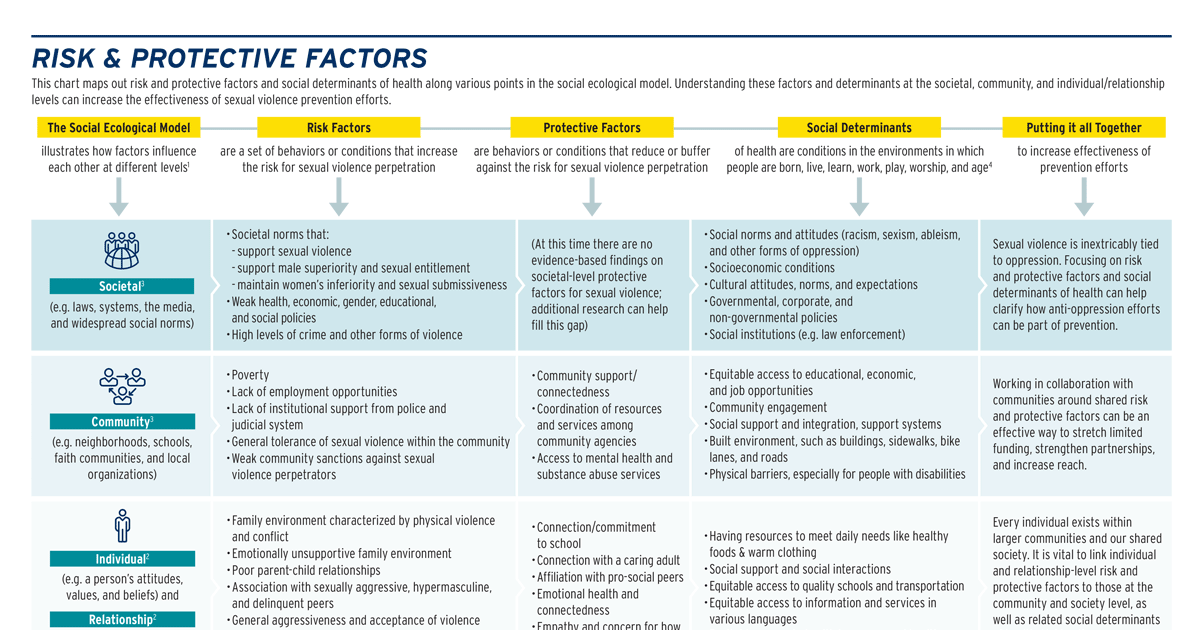
Risk and protective factors are a framework of things that can increase or decrease the likelihood of sexual violence perpetration.
My work and my passion is ending sexual violence – I’ve been in this movement for over 15 years in various roles, and I feel like one thing I’ve become good at is seeing how all of our different prevention efforts fit together. I can see how campus activists, policy-focused task groups, transformative justice workgroups, and folks who are training all of their church staff and volunteers on healthy boundaries are each important and interlocking pieces of the healthy society we are all creating together. I feel similarly about prevention theories (like the Public Health Model, the Social Ecological Model, and the 9 Principles of Effective Prevention Programs) – to me, they are like spider’s silk that we can use to build a web that shapes and supports our work in ways that make sense for our communities. So when I first heard about risk and protective factors, I was all for it – another strand of silk to build the web!
But what are risk and protective factors, exactly? This is a way I like to say it: it’s a set of information – like a framework – of things in the world that can increase or decrease the likelihood of sexual violence perpetration. Some are things that can be changed (like a person’s empathy or a community’s cohesiveness) and some are things that cannot be changed (like experiencing violence as a child or having been negatively impacted by weak laws related to sexual violence). I’ve heard that sometimes the concept of “risk factors” and “protective factors” can sound blamey, as if they are meant to show fault about where we live, our past experiences, or our future possibilities. There is a real history of health research being used to oppress others, and we must be mindful of how we use public health data. Our role in prevention is to collaborate with communities, to help create the changes they want to see. My hope is that risk and protective factors can help us all know where we can be effective and when we are moving in the right direction.
Note: One important consideration when looking at risk and protective factors is that these are not causal – meaning, just because one (or more) of these factors applies to someone, it does not automatically mean that they will grow up to use violence against others. What it does mean is that there are areas of our lives, communities, and world that we can change in order to make it a better place for everyone – a place where we all thrive and where violence is less likely to happen (and is taken seriously when it does happen).
Years of research and theory have helped to identify where to focus our prevention efforts, which is where this set of risk and protective factors come in. The CDC conducted a systematic review of risk and protective factors for sexual violence perpetration and identified a number of factors at the individual and relationship levels of the social ecology that have been consistently supported by research. Research examining risk and protective factors for sexual violence perpetration at the community and societal levels remains very limited, though. So most risk factors identified at community and societal levels are theoretically derived and based on findings from the World Health Organization’s World Report on Violence and Health.
One thing I appreciate about this set of risk and protective factors is that many of them are also identified factors for other forms of violence. This means that we can work with other movements that are sometimes mistakenly not considered part of sexual assault prevention (like pay equity or racial justice), and have evidence that our shared work is also making an impact for decreasing sexual violence perpetration. This is vital, because every community is different and will have their own interests, expertise, and focus – so we can find common ground among these shared risk and protective factors.
If this is interesting to you, I invite you to check out our newest resource – Risk and Protective Factors Infographic . This resource shows risk and protective factors at different levels of the social ecology, as well as corresponding social determinants of health (which are conditions and opportunities where we live, learn, work, and play). Implications for our field are included, giving insight about ways these factors can be used to inform our work and make it specific to the communities we are working with.
My next blog post will contain some examples of ways risk and protective factors can be used in prevention work, so stay tuned!
